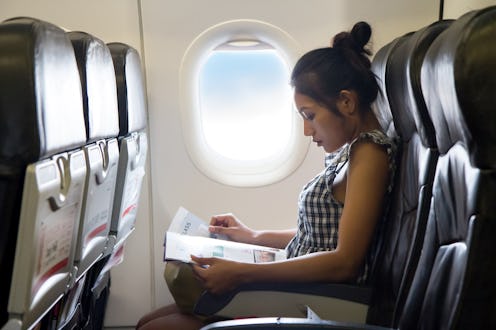Life
Here's How To Make Sitting On A Plane More Comfortable, According To Experts

I love flying. I do not, however, love how super cramped and achy my entire body gets after even a short flight, and frankly can't imagine what kind of superhuman powers someone who endures long flights on the regular has to possess. But for those of us who don't possess endurance powers, there are tricks to minimizing the general discomfort of plane travel, and those tricks begin with learning the best way to sit comfortably on a plane, to help mitigate both in-flight and post-flight discomfort.
"Staying in the same position makes it more likely for you to feel muscle and joint stiffness, and sometimes even pain when you finally change positions," Amanda Brick, a physical therapist at Professional Physical Therapy, tells Bustle. This is *extremely* relatable for anyone who's been stuck on a long-haul flight and managed to fall asleep — while it's great that you got some shut-eye, knowing that your entire body will be on pins and needles once you wake up is less than pleasant.
But, the thing with planes is that there really isn't that much room to move around, so you kinda have to work with what you have. Brick's advice for sitting comfortably on an airplane is actually pretty simple. "Make sure you are sitting as far back in the chair as possible, so that there is no space between your hips and the back of the seat." Once you're snug to the back of the seat, you should roll up a sweatshirt or a blanket (which can be purchased from some airlines), and "while leaning slightly forward, place it at the start of your lower back," Brick says. She adds that having a blanket/sweatshirt in place will help you keep the best possible posture throughout your flight.
But even if you're keeping great posture, spending three or four or (be strong, y'all) twelve-plus hours in a cramped space is going to cause discomfort no matter what. Brick says you should try not to stay seated during the whole flight. Instead, you should get up to stretch every once in a while, doing stretches that involve "simply moving in the opposite position your joints are resting in."
Brick advises, "Stand up for a minute every so often to extend your knees, hips and back. Squeeze your shoulder blades together five times for five seconds to help your shoulders and neck." And last up, "Straighten your arms out in front of you for your elbows, and lift your heels up and down ten times for your ankles." She also says that you can help relieve in-flight tension by using a massage ball — or a lacrosse ball, in a pinch — when you travel. To use it, just "place the ball on the area that feels tight and use it similarly to how you would use a foam roller."
Chances are that you've probably experienced a flight where you didn't watch your posture, or didn't get up to stretch — and this can have detrimental effects. Brick says that staying in the same position "makes it more likely for you to feel muscle and joint stiffness, and sometimes even pain when you finally change positions."
She adds that if you have blood clotting issues, not moving around enough during a flight can put you at risk for deep vein thrombosis. But according to the Mayo Clinic, generally you're only at risk for deep vein thrombosis when you have a medical condition that messes with your blood's ability to clot, or if you don't move for a *really* long time, "such as after surgery or an accident, or when you're confined to bed."
Despite your best intentions, there's totally a chance that you might, say, get wrapped up in a good book and forget to stretch, or fall asleep at a weird angle. In those cases, you're going to have to do some post-flight work. Brick says if you're feeling tense after a flight, you can use either ice or heat to relieve your symptoms. "Applying ice on the area for 10-15 minutes can soothe pain, and applying heat for 10-15 minutes will decrease tension or tightness felt in a muscle," she explains. If you're feeling really gross, treat yourself to a massage, Brick says — always a nice thing if you're on vacation.
With airlines seemingly always looking at new ways to shrink the leg room and seat space we have on flights, those of us who fly economy are going to have to make sure we're doing what we can do help keep our bodies as healthy and happy as possible. Thankfully, these solutions are pretty low-tech and, while they won't make enduring multi-hour flights less boring, they will help keep us limbered up in the air and on the ground.